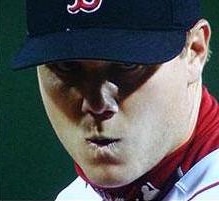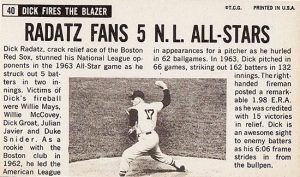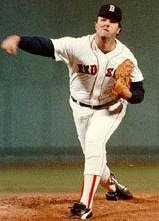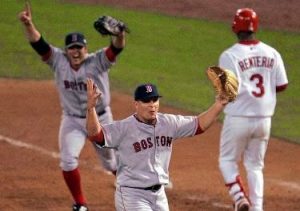To round out the Red Sox all-time pitching staff I will cover their five greatest relief pitchers ever. This is the third installment of my series of articles. Again, this covers how good they were as a Red Sox, and longevity plays into it. Craig Kimbrel was crazy filthy this season, but to be included he needs at least one more great year, probably two.
Jonathan Papelbon
Papelbon is the best reliever in Red Sox history, and would be their closer on an all-time roster. Papelbon is by far the all-time saves leader in franchise history with 219. He accomplished this with a 2.33 ERA, 1.02 WHIP and 10.7 strike outs per 9 innings pitched. Pap made 4 All-Star Games with the Red Sox. From 2006-2009 he was nearly unhittable, posting a 1.74 ERA and 0.92 WHIP. He had a WHIP under 1.00 in three straight seasons and an ERA under 2.00 in 3 out of 4. Hell, his ERA was under 1.00 in his rookie season of 2006.
Papelbon was also unhittable in the postseason and helped the Red Sox to the 2007 World Series championship. That season he threw 10.2 shutout innings in the playoffs and saved 3 games in the World Series. For his Boston career, Papelbon did not allow a run in his first 25 postseason innings, saving 7 games in that span. Remarkable. He was also a fun pitcher to watch, glaring at the hitter like he’s about to throw the ball through the batter’s head. Then there were also his wild celebrations after a successful save.


Dick Radatz
“The Monster” got his nickname for a reason: nobody wanted to face him. Standing at 6’6″, Radatz was an imposing figure on the mound. He became burned out quickly, unfortunately, pitching a lot of innings in relief. In his first 4 seasons Radatz averaged 135 innings pitched over 68 appearances. Compare that to your typical relief pitcher nowadays. During his first 3 seasons he made 2 All-Star Games, had a top 5 MVP finish and led the league in saves twice. During that span he had a 40-21 record and saved 98 games. In a time when batters were embarrassed to strike out, Radatz struck out 10.6 batters per 9 innings during those 3 seasons and had a 2.17 ERA.

Ellis Kinder
Ellis Kinder was a swingman for the Sox in the late 40s and 50s. In his first 3 seasons he made a lot of starts for the Red Sox while also relieving. He won 23 games in 1949, finishing 5th in the MVP vote. Two years later he led the league in appearances. By 1953 Kinder was a full-time reliever. That season Kinder was 10-6 with a 1.85 ERA and led the league in saves with 27. This was the 2nd time in three seasons Kinder had led the league in saves. For his Red Sox career, Kinder finished 86-52 with a 3.28 ERA and 93 games saved.

Bob Stanley
The all-time games pitched leader in franchise history has to make an appearance here. Stanley made starts in some years, but he was almost always a relief pitcher, and better at it then he was starting. Bob Stanley won 115 games and saved 132 during his career, which he spent entirely in Boston. As a relief pitcher his ERA was 3.28, opposed to being north of 4.00 as a starter. Stanley made 2 all-star teams and saved as many as 33 games in 1983.

Koji Uehara
Koji was always good, but often injured before coming to the Red Sox. No one could have predicted the impact he had on the team. In 2013, Koji was 4-1 with a 1.09 ERA and microscopic 0.56 WHIP. Then in the playoffs he allowed 1 run over 13.2 innings while saving 7 games. He was instrumental in their World Series run that season. Koji spent 4 seasons with Boston, saving 79 games. His rate statistics during that time were phenomenal; a 2.19 ERA, 0.81 WHIP and 11.6 strikeouts per 9 innings.

Koji Uehara of the Boston Red Sox reacts after defeating the St. Louis Cardinals 6-1 in Game Six of the 2013 World Series at Fenway Park on October 30, 2013. (Photo by Jamie Squire/Getty Images)
Special Mention
Keith Foulke needs to get an honorable mention in this article. He cannot make the top five Red Sox relievers ever, only having one good season, but he gave his career for that one season. Without him the Red Sox wouldn’t have broken the curse, beat the Yankees and won the World Series in 2004. Period. After a season in which Foulke had a 2.17 ERA and 0.94 WHIP, he amped up even further when the Sox needed him most. Foulke allowed 1 run over 14 innings in the playoffs, striking out 19 batters.
With their backs against the wall, down 0-3 to the Yankees in the ALCS, Foulke pitched in 7 of the final 8 games. During four of those appearances Foulke pitched more than the typical one inning. In Game 4 against the Yankees, he pitched 2.2 shutout innings, helping prolong the game to give the offense the opportunity to win it. What he did that postseason was nothing short of miraculous, and he was never the same afterwards. I’m sure he would do it all over again.

Boston Red Sox pitcher Keith Foulke, center, and first baseman Doug Mientkiewicz, left, celebrate after St. Louis Cardinals’ Edgar Renteria (3) grounded out to end the ninth inning and give Boston a 3-0 win and a sweep of the World Series, Wednesday Oct. 27, 2004, in St. Louis. (AP Photo/Mark Humphrey)
